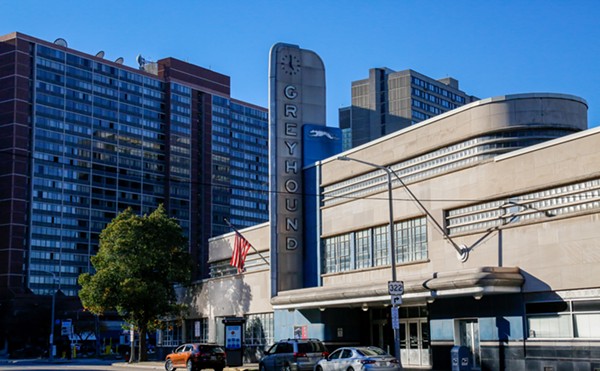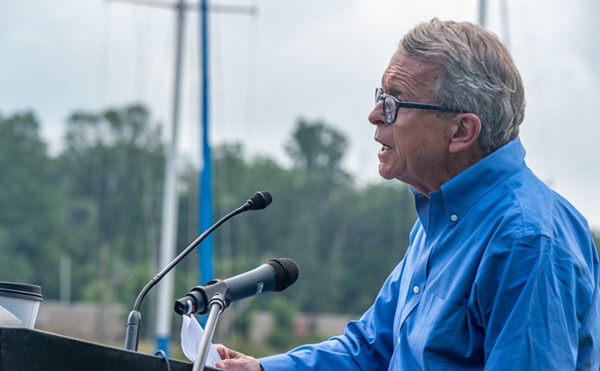The Chip on Cleveland's shoulder is old. We didn't develop the us-against-the-world mentality when the jobs went away. The Chip was here before the river burned, before the city defaulted. The Chip is older than Harvey Pekar, older than white flight, older than the Great Depression. In fact, the Chip is as old as Cleveland itself.
As founding fathers go, Moses Cleaveland was something of a deadbeat. Cleaveland and his men rolled through in 1796. After spending all of two weeks mapping plots and townships, Cleaveland and party headed home to Connecticut, never to return. As late as 1800, there was a grand total of one white settler in Cleveland. Disease was endemic in the river valley. People came, but once they realized that they'd arrived in a malarial nowhere, they left, just like the city's namesake. The solitary gringo, Lorenzo Carter, dealt with the flies and the boredom with a technique that remains popular: He drank whiskey at his trading post.
Others eventually trickled in and the city eventually boomed. But Carter never completely surrendered the bitterness that sticking it out had bred. His tombstone is the first and best historical evidence of the Chip. The epitaph on the grave he shares with his wife: THEY REMAINED — OTHERS FLED.
Lorenzo Carter, fairy godfather of the Chip, is buried in the shadow of Progressive Field. Imagine Carlos Santana, batting lefty, crushing one to right field. If that imaginary home run went through the stands and bounced across East 9th Street, it would roll to a stop right about on top of Carter's grave at the western edge of the Erie Street Cemetery across the street.
"I hate this f*&$%g song."
The Chip is dead. Cleveland, as a collective psychology, no longer cherishes our shoulder damage. Maybe the change has something to do with Millennials. Or perhaps we just stopped needing the defense mechanism. Our inferiority complex is now mostly restricted to T-shirt slogans. When a psychic injury reaches the point of novelty memehood, it can't truly hurt you anymore. Welcome to Believeland. Cleveland against the World. Keep Calm and Resent Outsiders.
Cleveland is hardly utopian. We still have a busted economy, lousy leadership, a troubled police force, staggering inequality, crumbling infrastructure, winter weather, and the Browns. The rebirth of the past decade has largely excluded African-Americans and the poor. Cleveland isn't heaven; no place is. We haven't fixed all our problems, but we've at least learned to talk about them frankly. The Chip won't stop us from tending our garden. The Chip is dead, long live the Chip.
"They're still shitty."
The Chip is no more, except for this one tiny thing. Sports—the measuring post of our civic self-esteem—are the one place where the Cleveland Chip still thrives. Our championship drought is 51 years young. The post-1999 Browns have the organizational equivalent of early Cleveland malaria. The Cavs have a real shot for as long as LeBron and Kyrie stick around. But as anyone who was awake in January can remember, the Chip and its attendant anxieties lurk just beneath the surface, in chill mode. And then there's the Indians. Funny you should mention them.
"You know, these guys aren't so f*&$%g bad."
When Sports Illustrated put Tribe stars Corey Kluber and Michael Brantley on its cover, wailing could be heard all along I-480. The Chip is alive and well. The Chip says it will never die. The Chip says it has a special corner dedicated to the last time Sports Illustrated pulled this stunt. Fans too young to even remember Corey Snyder's rifle arm and feathered mullet know about the "Indian Uprising" cover. As Joe Posnanski once observed, Chief Wahoo is the third happiest guy on the front of that issue.
The optimistic among us rationalized: This was a regional cover of Sports Illustrated. Sure, the Indians were on a cover, but it was only one of four covers of the mag's MLB preview. If the cover curse still obtains, then we can only expect a quarter-strength dose of it. It's almost like a jinx vaccine when you think about it that way.
But then we actually opened the issue. Sports Illustrated only featured Kluber and Brantley on 25 percent of the covers, but in every single copy of the magazine, on the page of predictions for the upcoming season, under "2015 World Series winners," it says Cleveland Indians.
"We should have gotten a live chicken."
In an essay in his sterling 2014 collection The Hard Way on Purpose, David Giffels recounts his childhood experience as a ballboy for the Cavaliers of the Ted Stepien era. He came to see the relationship between a doofy losing team and its fans not as one-way adoration, but as co-dependence. The old, bad Cavs "needed to be loved. And the people of my place and time needed something to love," Giffels writes.
Any Cleveland fan will recognize the truth of that statement. But the Indians, despite being far more competitive than the Browns and Cavs over the past few seasons, can't get any of that excess love. Their home attendance in 2014 averaged 18,400 per contest. Despite standout pitching and a winning club, Clevelanders filled 42.4% of the seats at Progressive Field on a typical gameday, by far the lowest percentage in MLB.
The front office is throwing money at the problem: A ballpark makeover will bring beloved local eateries (Melt, Sweet Moses, Barrio) to the outfield plaza. $13 will get you a standing room ticket and a beer. Season ticket prices are scandalously affordable. These enticements should help, but the underlying question remains: In a city starving for a winner, why can't the Tribe attract a following?
"Win the whole f*&$%g thing."
There's not a simple answer. Part of the issue no doubt is that baseball fans are older and more suburban on the whole. A pilgrimage from Ohio City or Tremont for a Cavs game isn't that big of a commitment; Browns games are scarce enough -- and primarily on weekends -- to justify schlepping in from Solon or Strongsville or beyond. To boot, the Indians suffer from a glut of product. You have 81 chances every year. It's not that tempting to sit through a 45-degree April weeknight game when you can tune in at home.
Short of LeBron pulling a Michael Jordan and learning to play third base, it's hard to conceive of a silver bullet to fix the Tribe's shrinking fanbase. Apart from the biggest, silverest bullet of them all: A championship. And in truth, no other Cleveland team deserves the honor of finally burying the Chip right alongside Lorenzo Carter. The Browns skipped town, after all. Yes, Vegas odds and common sense says if any Cleveland team will end the drought, it's the Cavs. As glorious and overdue as that celebration would be, it would be a mild miscarriage of poetic justice. After all, the Cavs didn't even exist in 1964, the last time we had a champion. Besides, the Cavs played for twenty years in a pasture halfway to Canal Fulton.
But the Indians have been here, without interruption, for a century and change, through thick and thin, through problematic logos and multi-decade slumps. In a city that lives and dies with its sports teams, wouldn't it only make sense that the team whose World Series drought is old enough to collect Social Security puts the final spackle to our collective Chip on the shoulder?













